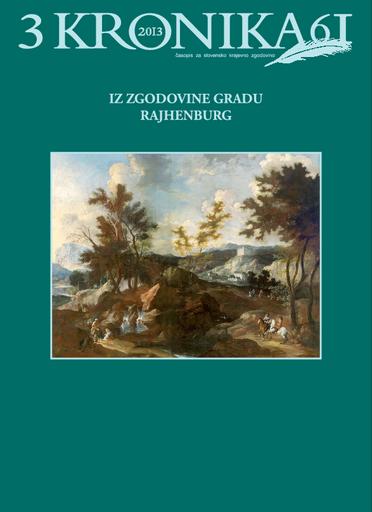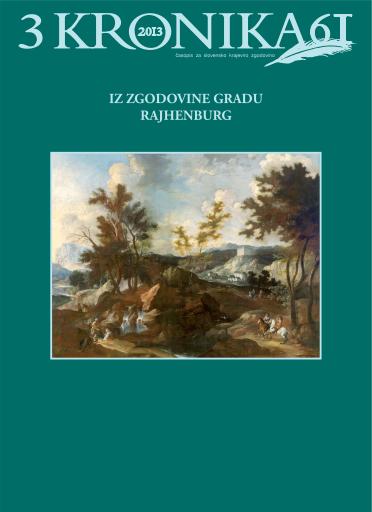/
Serijske publikacije
/
Kronika: časopis za slovensko krajevno zgodovino
Rajhenburški do začetka 15. stoletja

Avtor(ji):Boris Hajdinjak
Soavtor(ji):Miha Preinfalk (odg. ur.), Barbara Šterbenc Svetina (teh. ur.), Alenka Cizel (prev.), Manca Gašperšič (prev.), Andreja Jankovič Deržič (prev.), Dejan Zadravec (prev.), Lidija Slana (prev.), Meta Osredkar (prev.), Agencija MultiLingual (prev.), Irena Bruckmüller Vilfan (prev.)
Leto:2013
Založnik(i):Zveza zgodovinskih društev Slovenije, Ljubljana
Vir(i):Kronika, 2013, št. 3
Jezik(i):slovenščina
Vrst(e) gradiva:besedilo
Ključne besede:salzburška nadškofija, gradovi, plemstvo, genealogija, heraldika, Rajhenburg, Rajhenburški, Reštanj, Reštanjski, Turn v Brestanici, Tvarog, Tvaroški, Šperenberk, Šperenberški, Bishopric of Salzburg, castles, nobility, genealogy, heraldry, Reichenburg/Rajhenburg, Lords of Reichenburg, Reichenstein/Reštanj, Reichenstein family, Turn at Brestanica, Twarog/Tvarog, Lords of Twarog, Sperrenberg/Šperenberk, Lords of Sperrenberg
Avtorske pravice:

To delo avtorja Boris Hajdinjak je ponujeno pod Creative Commons Priznanje avtorstva-Nekomercialno-Brez predelav 4.0 Mednarodna
Datoteke (1)

Ime:kronika-2013_3.pdf
Velikost:66.73MB
Format:application/pdf
Stalna povezava:https://hdl.handle.net/11686/file18349
Opis
Grad Rajhenburg sodi med najpomembnejše in najbolj poznane slovenske gradove. Vendar bi moral biti njegov
pomen v večji meri kot do zdaj povezan tudi s po njem imenovano rodbino vitezov Rajhenburških. Rajhenburški
sodijo nesporno med najpomembnejše plemiške rodbine poznega srednjega veka in 16. stoletja z ozemlja nekdanje
dežele Štajerske kot tudi današnje države Slovenije. V članku je predstavljena zgodovina gradu in rodbine do
začetka 15. stoletja, ko delovanje rodbine preseže okvir lokalne zgodovine Posavja. S tem obdobjem zgodovine
Rajhenburških je neločljivo povezana tudi zgodovina domnevno sorodnih rodbin z gradov okoli Rajhenburga:
Tvarog Reštanj in Šperenberk.
Metapodatki (12)
- identifikatorhttps://hdl.handle.net/11686/35007
- naslov
- Rajhenburški do začetka 15. stoletja
- The Lords of Reichenburg until the beginning of the 15th century
- ustvarjalec
- Boris Hajdinjak
- soavtor
- Miha Preinfalk (odg. ur.)
- Barbara Šterbenc Svetina (teh. ur.)
- Alenka Cizel (prev.)
- Manca Gašperšič (prev.)
- Andreja Jankovič Deržič (prev.)
- Dejan Zadravec (prev.)
- Lidija Slana (prev.)
- Meta Osredkar (prev.)
- Agencija MultiLingual (prev.)
- Irena Bruckmüller Vilfan (prev.)
- predmet
- salzburška nadškofija
- gradovi
- plemstvo
- genealogija
- heraldika
- Rajhenburg
- Rajhenburški
- Reštanj
- Reštanjski
- Turn v Brestanici
- Tvarog
- Tvaroški
- Šperenberk
- Šperenberški
- Bishopric of Salzburg
- castles
- nobility
- genealogy
- heraldry
- Reichenburg/Rajhenburg
- Lords of Reichenburg
- Reichenstein/Reštanj
- Reichenstein family
- Turn at Brestanica
- Twarog/Tvarog
- Lords of Twarog
- Sperrenberg/Šperenberk
- Lords of Sperrenberg
- opis
- Grad Rajhenburg sodi med najpomembnejše in najbolj poznane slovenske gradove. Vendar bi moral biti njegov pomen v večji meri kot do zdaj povezan tudi s po njem imenovano rodbino vitezov Rajhenburških. Rajhenburški sodijo nesporno med najpomembnejše plemiške rodbine poznega srednjega veka in 16. stoletja z ozemlja nekdanje dežele Štajerske kot tudi današnje države Slovenije. V članku je predstavljena zgodovina gradu in rodbine do začetka 15. stoletja, ko delovanje rodbine preseže okvir lokalne zgodovine Posavja. S tem obdobjem zgodovine Rajhenburških je neločljivo povezana tudi zgodovina domnevno sorodnih rodbin z gradov okoli Rajhenburga: Tvarog Reštanj in Šperenberk.
- The Reichenburg (present-day Rajhenburg) Castle is one of the most important and best known Slovenian castles. Nevertheless, its significance should be linked, more than it presently is, with the Lords of Reichenburg, which obtained its name after it. The Reichenburg family was undoubtedly one of the most important noble families of the late Middle Ages and the 16th century in the territory of the former province of Styria, as well as in the present-day Slovenia. The paper presents the history of the castle and family until the beginning of the 15th century, when the Reichenburgs’ influence reached beyond the bounds of the local history of the Posavje area. This period in the history of the Lords of Reichenburg is inseparably linked to the history of allegedly related families from castles around Reichenburg: Twarog (Slo.: Tvarog), Reichenstein (Slo.: Reštanj) and Sperrenberg (Slo.: Šperenberk).
- The Lords of Reichenburg, named after the homonymous castle, were undoubtedly one of the most important noble families of the late Middle Ages and the 16th century in the territory of the former province of Styria, as well as in the presentday Slovenia. Roland Schäffer has authored the most comprehensive study of the family history ever by writing about its most important member, Reinprecht I of Reichenburg († 1505), Governor of Styria in 1494–1505. Although in the said work, Schäffer focused only on a fragment of the 429- years-long history of the family, other Lords of Reichenburg had an important standing as well, e.g. Reinprecht’s father Hans I of Reichenburg († after 1450), who was Governor of Duino (Slo.: Devin) for at least twenty-one years, with interim periods of acting as Governor in Mitterburg (present-day Pazin) and in his final years as Governor of Rann (present-day Brežice). Reinprecht’s son Hans III († 1522) wielded significant social influence as well. This is, not least, also attested by his death in the national assembly in Nürnberg, where he acted as a representative of the Austrian lands. Since some necessary partial research still has not been done and given the limited scope of this paper, the latter focuses on presenting the history of the castle and family until the beginning of the 15th century, when the influence of Lords of Reichenburg transcended the bounds of the local history of the Posavje area. This period in the history of the Lords of Reichenburg is inseparably linked to the history of allegedly related families from castles around Reichenburg (present-day Rajhenburg): Twarog (Slo.: Tvarog), Reichenstein (present-day Reštanj) and Sperrenberg (present-day Šperenberk). Neither of the earliest indications of Reichenburg, the first from 895 and the second from 1043, is authentic. It should be borne in mind that even though reference was made to a place with a typical »castle name«, i.e. »Richenburch«, there was not a single explicit indication suggesting the existence of a castle. What is more, the local name Reichenburg could not have existed prior to the construction of the castle. The actual time at which the castle with the same name emerged, i.e. between 1131 and 1147, was recorded by the author of the curriculum vitae of Conrad I, Archbishop of Salzburg, written between 1170 and 1177. This datum is incongruence with the reference to the first Lord of Reichenburg, Otto I, in 1141. The said reference is the first authentic reference to Reichenburg and as such also the first reference to the homonymous castle serving as the centre of the estate, which the Bishopric of Salzburg held in the Posavje region, and as an occasional residence of the Archbishops of Salzburg until the mid-13th century. At the beginning of the 14th century followed some references to five other members of the Reichenburg family, from which it is impossible to draw a reliable genealogy. In the first half of the 13th century, if not earlier, the tower was built below the Reichenburg Castle, which now forms the core building of the Turn Mansion (Germ.: Turm an der Sawe) at Brestanica. Since then, the tower below the castle first served as a residence to at least a part of the Reichenburg family. In the 13th century, another two castles, Reichenstein and Twarog, were constructed as fiefs of the Bishopric of Salzburg north of Reichenburg. Sources provide no basis on which it would be possible to equate the Lords of Reichenburg with the Lords of Reichenstein or Twarog. Quite to the contrary: given the absence of any explicit reference to their relatedness and considering the coats of arms on the preserved seals, it is safe to assume that these were three distinct families. At the end of the 13th century, Sperrenberg Castle emerged in the vicinity of Reichenburg as another fief of the Bishopric of Salzburg, but its exact location has never been determined. Ever since its first mention in 1300, Sperrenberg has always been referred to as the »site of former castle«, »Burgstall«, hence as the castle’s ruins, which makes it impossible to equate it with Turn at Brestanica. The first known Sperrenberg, Reinprecht I from 1300 also owned the Twarog Castle, from which it follows that the Lords of Sperrenberg and Twarog were members of the same family. This is also confirmed by the coats of arms on the preserved seals. The Twarog Castle was indirectly mentioned in connection with Wulfing of Twarog (1316–1326) and never again. This implies that the said castle fell to ruins already in the 14th century. At least by the mid-14th century, the Lords of Sperrenberg played a more important role than the Lords of Reichenburg. They reached their zenith with Wilhelm I (1339– 1362). The last member of the family was George (1399–1414), who was named after Reichenstein. After George stopped being mentioned in sources, the site of the Sperrenberg Castle ruins became a fief of the Lords of Reichenburg, without any written record of this being a case of inheritance. The Reichenstein Castle, too, came into the possession of the Reichenburg family, but only at the end of the 15th century and as part of the Sevnica (Germ.: Lichtenwald) seigniory. A more reliable genealogy of the Reichenburg family can be made from the 14th century onward. Key to understanding is the conclusion that Gottfried of Reichenstein († before 1317) was not a member of the Reichenburg family. In the following generation, distant cousins Frederik II († ca. 1380) and Henry III († 1377/80) founded two family branches: the older one, which became extinct in the male line in 1528, and the younger one, which became extinct in 1570. Their period was marked by the bestowal of the hereditary castellanship at the Reichenburg Castle, and hence its use as residence, to the older branch of the family, while the younger one had to make do with the Turn Mansion. This was most probably related to the envy and perhaps even hatred, which led to a tale that has been preserved in folk tradition of the animosity between the Reichenburg brothers who killed each other. Until that time, the Reichenburg family ran operations that were characteristic of the life of lower gentry. The first quality shift followed in the next generation, whose central personage was the member of the younger branch, Niklas I (1380– 1412). Through his marriage arrangement, he came into the possession of the Drachenburg (present-day Kozje) Castle, which remained in the hands of the Reichenburg family until it became extinct. He was also the steward of the Gonobitz (present-day Konjice) Castle, which belonged to the Wallsee family. This marked not merely the time when the Reichenburgs’ influence transcended the bounds of local history of the Posavje area, but also the beginning of their cooperation with the Wallsee family, which helped the next generation with Hans I to catapult itself into the higher echelons of society.
- založnik
- Zveza zgodovinskih društev Slovenije
- datum
- 2013
- tip
- besedilo
- jezik
- Slovenščina
- jeDelOd
- pravice
- licenca: ccByNcNd
